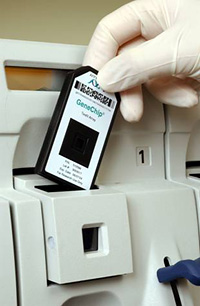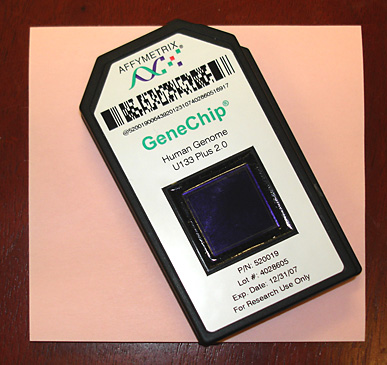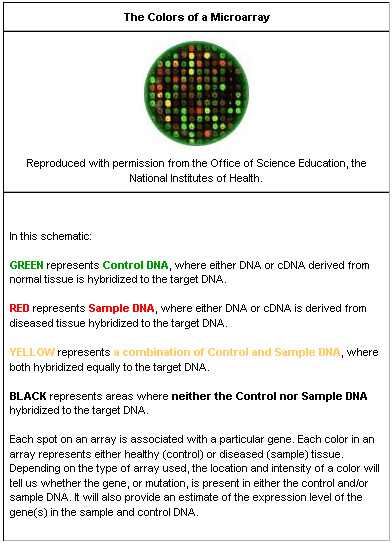Express Yourself: A Conversation with Chris Barker, Director of the Genomics Core Laboratory

Chris Barker
Modern science feeds on ideas. But ideas without technology are like a chef without a fully equipped kitchen. You can't taste success without testing it first.
Chris Barker, PhD, knows all about scientific appetites. As director of the Genomics Core Laboratory at the UCSF-affiliated J. David Gladstone Institutes for the last six years, he has parlayed a career as an itinerant scientist into one as a manager of discoveries.
"Science is a business, something that young scientists don't always understand right away. We are paid to make discoveries, just like Bill Gates has to create software for compensation."
It is a lesson the 54-year-old Barker, a trained virologist, learned early in his postdoctoral journey from Boston to Birmingham and from Philadelphia to Ann Arbor. "I've always liked playing with toys, yet it still took me a while to realize that I like to set things up, be it a new system or a new lab. The truth is, too, that I have a short attention span. It's not a good idea for me to go after a problem where I have to selectively focus for an extended period of time."
Instead, Barker now helps other scientists "intensely focus on a project and follow it logically."
How does the onetime vice president of molecular biology (a position Barker once held at a life sciences start-up) manage this? To answer that question, we first need to understand a bit about DNA microarray technology, which — excuse the pun — is at the core of the Genomics Core Laboratory, where Barker's two employees and half a dozen or so gene chip scanners and networked computers generate their mounds of data.

We all know that most cells in our body contain a full complement of genes and chromosomes. We also understand that not all of the genes are turned "on" in the same way — or to the same degree — in every cell. If they were, all of our 300 or so different cell types, from bone to skin, wouldn't exist, which means that neither you nor I would, either. Instead, we would all be obliviously living out our lives as single-celled bacteria or algae.
Be thankful, then, that humans are multicellular organisms with big brains, and that we have used these brains to give the process that makes our different cells a name. That name is gene expression. Put a little more scientifically, gene expression is the term used to describe what happens when the information that genes contain is transcribed by messenger RNA and translated into proteins.
DNA microarrays, which arose from an earlier macroarray technology of the 1980s, tap into this expression process by exploiting the fact that messenger RNA molecules bind to the specific DNA segments they originally transcribed. In gene expression studies (that use microarray technology), cells from diseased tissue can be probed with fluorescently labeled nucleic acid molecules, digitally photographed and then analyzed by special computer software to reveal the level of gene expression.
Imagine, for example, being able to track back from a cancer cell to a specific gene or set of genes, and you begin to understand how essential such research has become to uncovering the underlying mechanisms of disease. The same is true for tumor classification, risk assessment, prognosis, drug development and drug response, all of which have been transformed by this ability to see and hear the marquee speakers at the genome convention.

The microarray process also can work the other way around. Place nucleotides associated with known gene sequences on a glass slide and then run tissue samples against them, and the same binding process will reveal the relative abundance of tens of thousands of genes — all from a chip about half the size of a standard Post-it note.
With so much potential data, researchers could quickly drown in the deluge without a manager like Barker to orchestrate the discovery process at the outset. "We'll do what any researcher wants, but in the project description that all scientists are required to fill out, we ask specifically what they are trying to accomplish. And then we sit down with them and ask the important questions. Scientists always know what they want, but they have varying degrees of information about what they can get."
And before anyone picks up a pipette, Barker recruits a biostatistician to review the proposal to ensure that robust statistical data will rise to the top.
"When you boil down a DNA microarray experiment, what you're really doing is getting a comparison. PIs [principal investigators] need to decide what comparisons they want to do. It's a big decision because the arrays have expanded now. There are a lot more options and the samples can be tiny. It's not an exaggeration to say that we can compare anything."

The tests themselves cost anywhere from $300 to $800 each. And even the simplest studies in what Barker describes as his "million-dollar lab" usually require at least three test samples and three real samples. "No one knew in the early days how much biological noise would spill out when you are running so many gene tests at once," Barker explains. Now, six to 12 tests are the norm, with some clinical studies requiring 50 or more.
The list of scientists making their way to Gladstone headquarters at UCSF Mission Bay — including Frank McCormick, PhD, Doug Hanahan, PhD, Thea Tlsty, PhD, Shaun Coughlin, MD, PhD, and Mike McManus, PhD, among dozens of others — reads like a UCSF Who's Who. And why not? Microarrays are cool, clean and content-rich, if a little labor-intensive to produce.
Better yet, they serve Barker's higher purpose. "I'm a bookworm. When I was a child, I used to read encyclopedias. These days, I also think of myself as a translator, someone who has lived in and escaped the postdoc ghetto, who knows how to put together a lab from the ground up and who understands the experimental side of science."
To this list of titles we should also add budding Italian cook. "I gave up my lab bench a long time ago," Barker laughs. "Now I do my molecular biology at the stove. I want to have fun. Science taught me that."
Alternative content
Related Links
- Genomics Core Laboratory
- DNA Microarray
- Wikipedia
- Microarrays: Chipping Away at the Mysteries of Science and Medicine
- National Center for Biotechnology Information, National Library of Medicine, National Institutes of Health
- A History of DNA Microarrays
- Pharmaceutical Discovery, September 1, 2005